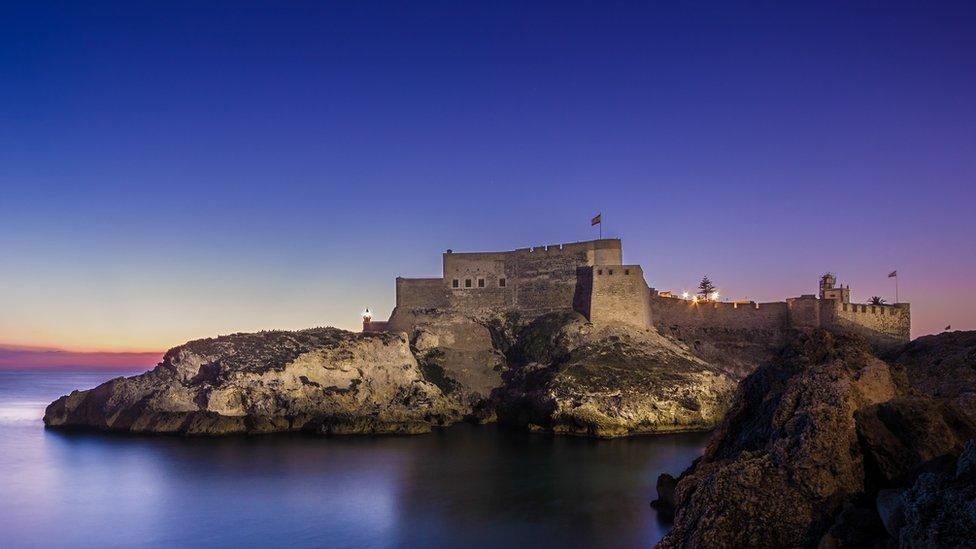Ceuta, Melilla profile
- Published
This page is no longer being updated. It was last updated on 18 May 2023

The tiny Spanish enclaves of Ceuta and Melilla sit on the northern shores of Morocco's Mediterranean coast. Together they form the European Union's only land borders with Africa.
Ceuta and its larger sister city Melilla, situated some 400km further south along the coast, trace their Spanish past to the 15th Century.
Coveted by Morocco, they have long been a flashpoint in diplomatic relations with Spain. Madrid asserts that both territories are integral parts of Spain and have the same status as the semi-autonomous regions on its mainland.
Historically, both port cities developed as military and trade centres linking Africa to Europe. Since 1995, they have enjoyed a limited degree of self-government as Autonomous Communities.
Unemployment among the native workforce is more than 30%, among the highest rates in Spain. The cities are a magnet for thousands of traders and menial workers who cross the border from Morocco each day to earn a living.
Increasingly Ceuta and Melilla's heavily fortified borders have come under pressure from African migrants seeking a better life in Europe. Human rights groups and the European Union have raised concerns with Madrid about the deportation of illegal immigrants.
Read more country profiles, external - Profiles by BBC Monitoring, external
CEUTA, MELILLA: FACTS
Combined area: 30.8 sq km
Population: 85,100 (Ceuta) 86,400 (Melilla)
Languages: Spanish, also Arabic
Life expectancy, Ceuta: 75 years (men) 81 years (women)
Life expectancy, Melilla: 76 years (men) 82 years (women)
LEADER
Head of State: King Felipe VI

Spain's King Juan Carlos angered Morocco by visiting Ceuta in 2007
Ceuta and Melilla enjoy local autonomy and have their own governments, led by city presidents. They return deputies and senators to the Spanish parliament. Until 1995 they were administered by provincial governments - Cadiz for Ceuta, and Malaga for Melilla.
MEDIA

The national networks of Spain's public broadcaster, RadioTelevision Espanola (RTVE), are available in Ceuta and Melilla. They are served by commercial stations.
Press
El Faro, external - Ceuta and Melilla
El Telegrama, external - Melilla
Radio
SER Ceuta, external - commercial
COPE Ceuta, external - church-controlled
Cadena Dial Melilla, external - commercial
TIMELINE
Some key dates in the history of Ceuta and Melilla:

5th Century - Ceuta and Melilla are successively colonised by the Carthaginians, Greeks and Romans.
8th Century - Ceuta is ruled by various Berber and Arab dynasties.
1415 - Portugal seizes control of Ceuta.
1497 - Spain conquers Melilla, a long history of attacks and siege by Muslim forces follows.
1556 - Melilla comes under Spanish rule.
1688 - Ceuta remains under Spanish control after the union between Portugal and Spain ends.
1936 - Melilla is the first Spanish town where the military garrison revolts against the Popular Front Government at the start of the Spanish Civil War.
1956 - Spain retains Ceuta and Melilla after Morocco becomes independent.
1995 - Spain approves Statute of Autonomy for Ceuta and Melilla.
2002 - Moroccan and Spanish forces clash over the islet of Perejil off Ceuta.
2007 - Visit by Spain's King Juan Carlos reignites Moroccan claims of sovereignty.
2018 - Following Europe's 2015 migration crisis, as the EU restricted the movement of people from Turkey and Libya - arrivals from Morocco to Spain rise significantly.
2022 June - At least 23 people are killed when about 2,000 migrants attempt to scale the border fence between Morocco and Melilla.

Migrants often try cross the substantial border fences separating both Ceuta and Melilla from Morocco
- Published22 March 2024

- Published21 August 2023

- Published19 May 2023

- Published28 October 2024

- Published28 October 2024
